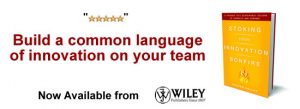Business Models Aren't Just For Business
 During my six years as an accidental bureaucrat, after spending twenty-five years in the private sector, my friends often wondered how I could do it. They routinely asked versions of the question: doesn’t government move too slowly for you? My standard reply was that, yes, the public sector moves slowly – but then, big companies don’t move so quickly either. And come to think of it, I teased my friends in higher education, colleges and universities move more slowly than either business or government! The point is, all institutions move slowly.
During my six years as an accidental bureaucrat, after spending twenty-five years in the private sector, my friends often wondered how I could do it. They routinely asked versions of the question: doesn’t government move too slowly for you? My standard reply was that, yes, the public sector moves slowly – but then, big companies don’t move so quickly either. And come to think of it, I teased my friends in higher education, colleges and universities move more slowly than either business or government! The point is, all institutions move slowly.
What surprised me wasn’t how slowly the different institutions moved, but the different language, behavior, secret handshakes, and views of each other I found across sectors. Xenophobia runs rampant within public, private, non-profit, and for-profit silos. Each silo has created its own world completely foreign to inhabitants from other sectors. Visiting emissaries are always viewed with skepticism. (“I’m from the government and I’m here to help …”)
One epiphany from my immersion into the non-private sector is how strenuously social sector organizations resist the notion they have a business model. Non-profits, government agencies, social enterprises, schools, and NGOs consistently proclaim that they aren’t businesses, and therefore business rules don’t apply.
Well, I’m sorry to break the news, but if an organization has a viable way to create, deliver, and capture value, it has a business model. It doesn’t matter whether an organization is in the public or private sector. It doesn’t matter if it’s a non-profit or a for-profit enterprise. Allorganizations have a business model. Non-profit corporations may not be providing a financial return to investors or owners, but they still capture value to finance activities with contributions, grants, and service revenue. Social enterprises may be mission-driven, focused on delivering social impact versus a financial return on investment, but they still need a sustainable model to scale. Government agencies are financed by taxes, fees, and service revenue, but are still accountable to deliver citizen value at scale.
The idea that business models are just for business is just wrong. Any organization that wants to be relevant, to deliver value at scale, and to sustain itself must clearly articulate and evolve its business model. And if an organization doesn’t have a sustainable business model, its days are numbered.
It may be, however, that the model is implicit rather than explicit.
It’s amazing how few organizations can clearly articulate their business model. Can yours?
If you ask any ten people in your organization how it creates, delivers, and captures, will the answers even be close?
If not, it’s probably because, in the industrial era when business models seldom changed and everyone played the game by the same set of well-understood industry and sector rules, it wasn’t as important to be explicit about business models. Business models were safely assumed and taken for granted.
That won’t work in the 21st century when all bets are off. Business models don’t last as long as they used to. New players are rapidly emerging, enabled by disruptive technology, refusing to play by industrial era rules. Business model innovators aren’t constrained by existing business models. Business model innovation is becoming the new strategic imperative for all organization leaders.
Perhaps the most important reason for developing common business model language across public, private, non-profit, and for-profit sectors is that transforming our important social systems (including education, health care, energy, and entrepreneurship) will require networked business models that cut across sectors. We need new hybrid models that don’t fit cleanly into today’s convenient sector buckets. We already see for-profit social enterprises, non-profits with for-profit divisions, and for-profit companies with social missions. Traditional sector lines are blurring. We’re going to see every imaginable permutation and will have to get comfortable with more experimentation and ambiguity.
Economic prosperity and solutions for our big social system challenges require business model innovation across sectors. All organization leaders must learn how to do R&D for new business models. Non-profit, social enterprise, school, and government leaders aren’t exempt. Business models aren’t just for business.
You can also see this post here on the Harvard Business Review site.
Don’t miss an article (2,500+) – Subscribe to our RSS feed and join our Innovation Excellence group!
 Saul Kaplan is the Founder and Chief Catalyst of the Business Innovation Factory (BIF). Saul shares innovation musings on his blog at It’s Saul Connected and on Twitter at @skap5.
Saul Kaplan is the Founder and Chief Catalyst of the Business Innovation Factory (BIF). Saul shares innovation musings on his blog at It’s Saul Connected and on Twitter at @skap5.
NEVER MISS ANOTHER NEWSLETTER!
LATEST BLOGS
The Evil Downside of Gift Cards
This past holiday season I saw probably one too many articles trumpeting the value of gift cards to retailers and how they are a great thing for retailers. My skeptic side starts coming out as I see article after article appear, and I have to start asking “Is the increasing prevalence of gift cards as a holiday gift (primarily Christmas) a good thing for retailers?”
Read MoreWhy the iPhone will not succeed – Yet
The new Apple iPhone is set to launch on June 29, 2007 and the press and investors are making it a darling. Investors have run Apple’s stock price up from about $85 per share before its announcement to $125 per share recently, but the iPhone still will not succeed – at least not yet.
Read More



